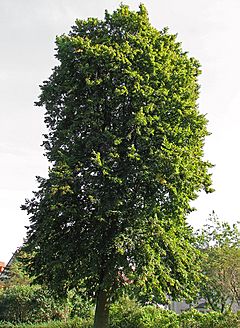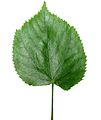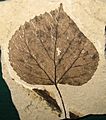Tilia facts for kids
Quick facts for kids Tilia |
|
|---|---|
 |
|
| Tilia platyphyllos | |
| Scientific classification | |
| Kingdom: | |
| Division: | |
| Class: | |
| Order: | |
| Family: | |
| Genus: |
Tilia
|
Tilia is a group of about 30 to 45 different kinds of trees. You can find them in the Northern Hemisphere, especially in Asia, Europe, and eastern North America. They are not found in western North America.
These trees are often called linden in North America and lime in Britain. Both names come from an old Germanic word, lind. In England, the word changed over time to lime. In the United States, the German name Linde became more common. This helped avoid confusion with the fruit called lime.
Tilia trees are large deciduous trees. This means they lose their leaves in the fall. They usually grow between 20 and 40 meters (about 65 to 130 feet) tall. Some types can even grow as shrubs.
Contents
History of Linden Trees
Long ago, the Germanic tribes thought the Linden tree was special. They linked it to the goddess Freyja. These tribes often held important meetings, called a Thing, near or under a Linden tree. They usually chose trees that stood alone in a field. During these meetings, they would make new laws. These gatherings often lasted for three days.
Types of Linden Trees
There are many different kinds of Tilia trees around the world. Here are a few examples:
- Tilia americana
- Tilia cordata
- Tilia henryana
- Tilia japonica
- Tilia mongolica
- Tilia nasczokinii
- Tilia platyphyllos
- Tilia tomentosa
Hybrid Linden Trees
Sometimes, different types of Tilia trees can mix together. This creates new kinds of trees called hybrids. For example, the Common Lime tree (Tilia × europaea) is a mix of two other Tilia species.
Uses of Linden Trees
Linden trees have beautiful, sweet-smelling flowers. These flowers produce a lot of nectar, which is great for beekeepers. Bees use the nectar to make a very light-colored and tasty monofloral honey.
The flowers are also used to make herbal tea. This tea is very popular in Europe. It is sometimes called "lime blossom" tea.
Images for kids
-
Lime nail galls, caused by tiny mites
-
T. johnsoni leaf fossil, 49 million years old
-
A statue of Saint George made from limewood
See also
 In Spanish: Tilos para niños
In Spanish: Tilos para niños
























